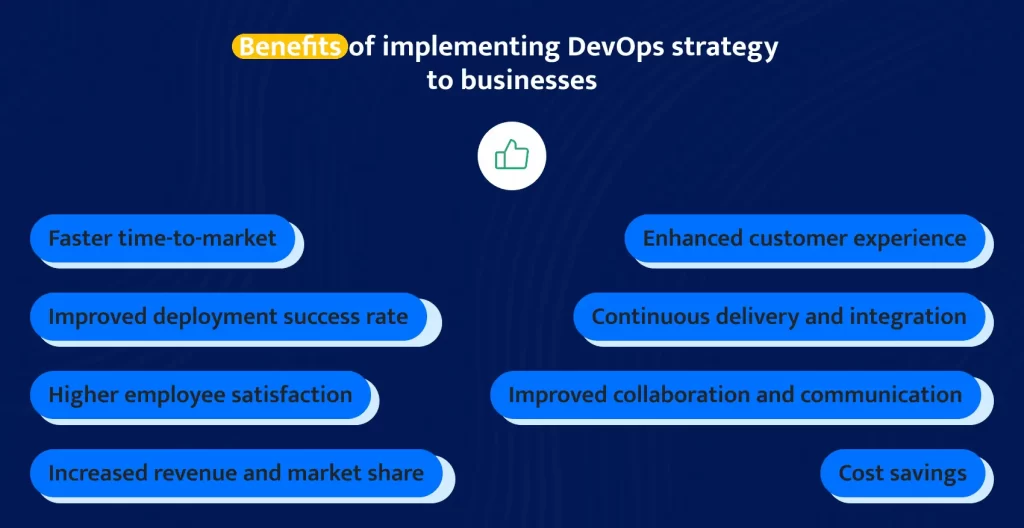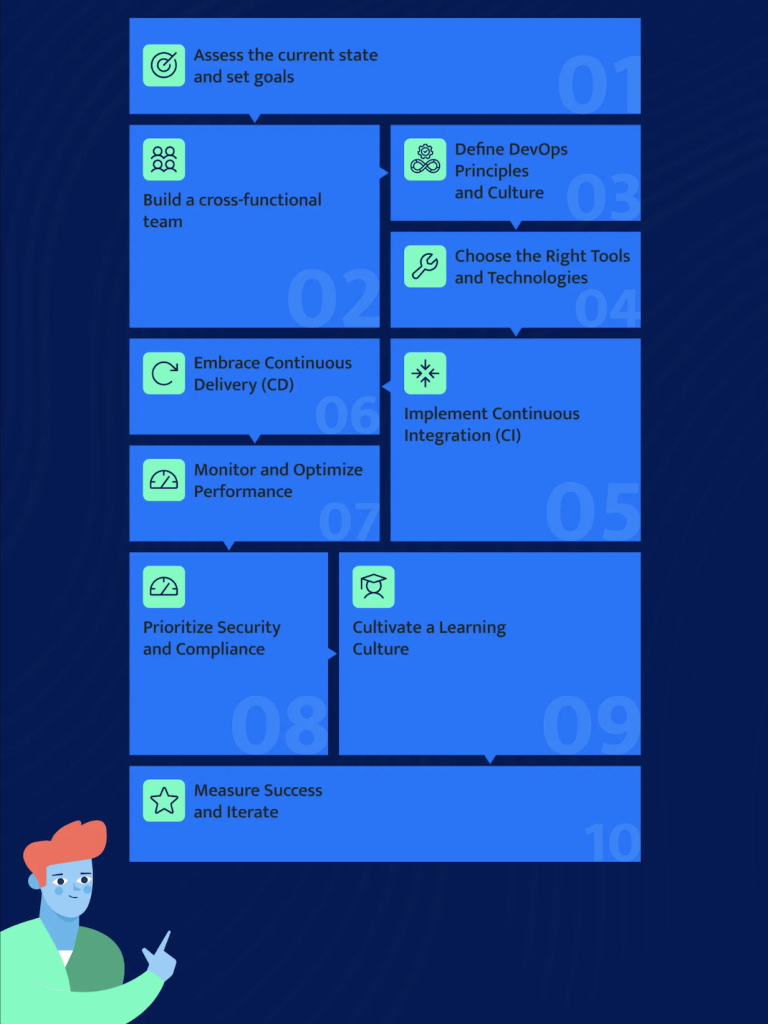Implement a Successful DevOps Strategy with Alternative-spaces Main Principles

In today’s rapidly evolving digital landscape, organizations constantly seek innovative ways to stay ahead of the curve. In this pursuit of excellence, the DevOps implementation strategy has emerged as a game-changer, providing the key to optimizing productivity, streamlining workflows, and fostering seamless collaboration between development and operations teams.
As the heartbeat of modern software delivery, DevOps empowers organizations to break free from traditional silos and embrace a continuous integration and delivery culture. In this article, we delve into the vital importance of DevOps in organizations and explore the transformative power of Alternative-spaces expertise in this field – the compass guiding you on your journey to a genuinely successful DevOps strategy.
Table of contents
- Benefits of Implementing DevOps Strategy to Businesses
- Key DevOps Strategies You Can Implement
- How to Create a Successful DevOps Strategy Roadmap: Alternative-spaces Step-by-Step Guide
- Alternative-spaces’s Expertise in How to Implement DevOps
- FAQ
Benefits of Implementing DevOps Strategy to Businesses
Implementing a DevOps strategy offers various transformative advantages to businesses across multiple industries. DevOps benefits to businesses include a culture of collaboration, agility, and continuous improvement by integrating development and operations teams and streamlining the software delivery process. These paragraphs will explore the significant benefits businesses can experience by adopting a robust DevOps approach.

Faster Time-to-Market
Organizations that implement DevOps effectively experience significant reductions in the time it takes to deliver new software features and updates. The State of DevOps report by Google Cloud highlights that organizations with mature DevOps practices are twice as likely to exceed their profitability, market share, and productivity goals. Faster time to market enables them to seize opportunities quickly and respond rapidly to changing market demands, leading to increased business success.
Improved Deployment Success Rate
DevOps deployment strategy leads to more reliable software deployments, resulting in a lower rate of failures. The DevOps Research and Assessment (DORA) report shows that high-performing DevOps organizations have a 440 times faster change lead time. This means they can quickly deliver code changes and updates to production environments, enabling more frequent and smaller deployments, reducing the risk of failures, and improving overall deployment success rates.
Higher Employee Satisfaction
DevOps promotes a collaborative and empowered work culture, increasing job satisfaction among IT professionals. In a survey conducted by Puppet, organizations with strong DevOps practices reported 50% higher employee Net Promoter Scores (NPS) than those with weak DevOps practices.
Increased Revenue and Market Share
Organizations can attract and retain more customers by accelerating the delivery of new features and updates, leading to increased revenue and market share. A study by the Harvard Business Review found that organizations that adopt DevOps practices experience 63% higher revenue growth and 2.5 times faster time-to-market. This demonstrates the direct correlation between DevOps implementation and improved business performance.
Enhanced Customer Experience
DevOps enables organizations to respond rapidly to customer feedback and demands, leading to a better customer experience. Google, for example, uses DevOps practices to continuously improve its services, resulting in high customer satisfaction and loyalty.
Continuous Delivery and Integration
DevOps facilitates continuous delivery and integration, allowing organizations to release updates frequently and reliably. Companies like Etsy, with a strong DevOps culture, deploy new code changes multiple times per day on average.
Improved Collaboration and Communication
DevOps improves collaboration and communication by breaking down silos between development, operations, and other teams. For instance, Microsoft’s DevOps transformation resulted in a 90% reduction in time to resolve issues and a 93% reduction in lead time for changes.
Cost Savings
DevOps automation and streamlined processes lead to cost savings in IT operations. For example, Capital One reported a 73% reduction in infrastructure provisioning time and a 47% reduction in IT operating costs after adopting DevOps.
These real examples and statistics demonstrate the tangible benefits of a successful DevOps implementation strategy, ranging from improved efficiency and customer satisfaction to increased revenue and market dominance. Embracing DevOps can transform organizations, making them more competitive and responsive in the fast-paced world of technology and business.
Key DevOps Strategies You Can Implement
This paragraph will explore key DevOps implementation strategies businesses can adopt to optimize their workflows and drive success in the dynamic digital era. From continuous integration and continuous deployment (CI/CD) to infrastructure as code and robust monitoring solutions, these strategies empower organizations to create a culture of agility, innovation, and seamless collaboration across all levels of their operations.
Infrastructure as Code (IaC)
Implementing Infrastructure as Code involves managing and provisioning infrastructure through machine-readable configuration files. This strategy ensures consistency and reproducibility across different environments, reducing manual errors and enabling faster deployments.
- Tools: Terraform, AWS CloudFormation, Ansible, Puppet.
Continuous Integration and Continuous Delivery (CI/CD)
CI/CD focuses on automating the code integration, testing, and delivery processes. It enables developers to continuously merge code changes into a shared repository, run automated tests, and deploy to production reliably and frequently.
- Tools: Jenkins, GitLab CI/CD, CircleCI, Travis CI.
Automated Testing
Automated testing involves creating and executing tests automatically to validate software functionality, performance, and security. This strategy helps identify issues early in development and ensures high-quality code. This approach is used for making regular releases without human resources involvement, if tests passed the application can be released, at least as nightly build. As a result our clients ship the newest features to their customers as fast as possible.
- Tools: Selenium, JUnit, TestNG, Cypress, Postman.
Microservices Architecture
Microservices architecture breaks down applications into more minor, loosely coupled services that can be developed, deployed, and scaled independently. This strategy promotes flexibility, scalability, and faster development cycles.
- Tools: Kubernetes, Docker, Istio, Linkerd.
Monitoring and Observability
Monitoring and observability focus on real-time insights into application performance and health. This strategy helps detect and resolve issues promptly, ensuring optimal system performance.
- Tools: Prometheus, Grafana, ELK Stack (Elasticsearch, Logstash, Kibana), New Relic.
Collaboration and Communication
Promoting a culture of collaboration and communication is essential for successful DevOps implementation. Breaking down silos between teams and encouraging open communication leads to better outcomes.
- Tools: Slack, Microsoft Teams, Jira, Confluence.
Version Control
Version control is crucial for tracking changes to code and infrastructure configurations. It allows teams to collaborate effectively, revert changes if needed, and maintain a history of all modifications.
- Tools: Git, GitHub, GitLab, Bitbucket.
Security as Code
Security as Code integrates security practices throughout the software development lifecycle. This strategy ensures that security measures are automated and included in the development process.
- Tools: SonarQube, OWASP ZAP, Snyk.
By implementing these key DevOps strategies and utilizing the appropriate tools, businesses can streamline their development and deployment processes, improve collaboration, and deliver high-quality software more efficiently. The whole development process will be working by using standards, and there won’t be any way to brake it by developers because of appropriate failure on the testing stage, where security scanning will be one part of Continuous Integration.
How to Create a Successful DevOps Strategy Roadmap: Alternative-spaces Step-by-Step Guide
At Alternative-spaces, we understand the transformative power of DevOps and its ability to drive innovation, collaboration, and efficiency within organizations. With our deep expertise in DevOps practices, we are anxious to share our knowledge and guide you in successful DevOps implementation steps tailored to your needs. Follow these principles of a DevOps implementation:

Step 1: Assess the Current State and Set Goals
Begin by assessing your organization’s current development and operations processes. Identify pain points, bottlenecks, and areas for improvement. Collaborate with key stakeholders to define clear and achievable DevOps goals aligned with your business objectives.
Step 2: Build a Cross-Functional Team
Form a cross-functional team with representatives from development, operations, quality assurance, and other relevant departments. This diverse team will ensure a holistic approach to crafting your DevOps strategy, fostering collaboration, and breaking down silos.
Step 3: Define DevOps Principles and Culture
Establish a set of guiding DevOps principles and define the desired culture within your organization. Emphasize collaboration, continuous improvement, automation, and shared responsibilities. Encourage open communication and a growth mindset across all teams.
Step 4: Choose the Right Tools and Technologies
Leverage our deep expertise to select appropriate DevOps tools and technologies that align with your goals. Consider CI/CD platforms, automation tools, monitoring solutions, and cloud infrastructure that will streamline your processes and enhance productivity.
Step 5: Implement Continuous Integration (CI)
Adopt a CI approach to automate code integration, build, and testing processes. Set up a CI pipeline that runs automated tests whenever code changes are committed, ensuring early detection of issues and faster feedback to developers.
Step 6: Embrace Continuous Delivery (CD)
Extend your CI pipeline to encompass continuous delivery. Automate the deployment of code changes to staging and production environments, ensuring reliable and frequent releases. Implement feature toggles to enable safer and controlled rollouts.
Step 7: Monitor and Optimize Performance
Implement robust monitoring and observability practices to gain real-time insights into application performance. Leverage monitoring data to identify performance bottlenecks and optimize your systems continually.
Step 8: Prioritize Security and Compliance
Integrate security as a fundamental aspect of your DevOps implementation strategy. Conduct security testing and ensure compliance with industry standards throughout the software development lifecycle.
Step 9: Cultivate a Learning Culture
Encourage a culture of continuous learning and improvement. Conduct regular retrospectives to reflect on successes and challenges, and use the insights to refine your DevOps practices continually.
Step 10: Measure Success and Iterate
Establish key performance indicators (KPIs) to measure the success of your DevOps strategy. Monitor progress, analyze results, and iterate on your approach to continually enhance your DevOps journey.
Alternative-spaces’s Expertise in How to Implement DevOps
At Alternative-spaces, a top software development company, we take great pride in our extensive expertise in developing and executing highly effective DevOps strategies that cater to the unique needs of businesses across diverse industries. Our seasoned professionals have extensive knowledge in software development, operations, and cloud technologies, enabling us to deliver cutting-edge solutions that streamline the entire development lifecycle. One of our notable strengths is our proficiency in implementing robust continuous integration and continuous deployment (CI/CD) pipelines. For instance, we worked with a software startup, streamlining their release process and reducing the time to market for their new features by 50%.
We also excel in cloud-native DevOps solutions, leveraging the power of cloud platforms such as AWS and Azure to enhance scalability and resource optimization. For a healthcare organization, we successfully migrated its infrastructure to the cloud, resulting in a 30% reduction in operational costs while maintaining the highest levels of security and compliance.
We emphasize the importance of monitoring and observability in DevOps. By integrating advanced monitoring tools like Prometheus, Zabbix, NewRelic, and Cloud native service (AWS CloudWatch), we assisted an e-commerce company in identifying and mitigating bottlenecks in their application (via high-loading the application and watching for resources usage via different run-time tools on servers), leading to a 40% increase in website performance and a significant boost in customer satisfaction. DevOps goal is to make products better and involve every developer in this process by sharing this culture with everyone.
Our commitment to excellence extends to automation and infrastructure as code. Adopting technologies like Ansible and Terraform enabled a technology firm to automate its infrastructure provisioning, drastically reducing deployment errors and achieving a 70% decrease in downtime.
In conclusion, our expertise in DevOps strategy at Alternative-spaces is characterized by our comprehensive approach, empowering businesses to achieve seamless automation, faster software delivery, and improved collaboration between teams. With a proven track record of successful implementations, we continue to drive innovation and propel businesses toward sustainable growth and success in today’s competitive landscape.
FAQ
Q1: What is DevOps?
A1: DevOps is a collaborative approach that combines development and operations teams to streamline software development, testing, and deployment processes for faster and more reliable releases.
Q2: Why is DevOps important for businesses?
A2: DevOps enables businesses to achieve faster time-to-market, improved product quality, and enhanced customer satisfaction through seamless collaboration and automation.
Q3: How do I start implementing a DevOps strategy?
A3: Begin by fostering a culture of collaboration, embracing automation tools, and establishing continuous integration and deployment pipelines.
Q4: What are the key principles of a successful DevOps strategy?
A4: The key principles include continuous integration and deployment (CI/CD), infrastructure as code, robust monitoring, automation, and a strong focus on collaboration and communication.
Q5: How can Alternative-spaces help with implementing a DevOps strategy?
A5: Alternative-spaces offers expertise in crafting tailor-made DevOps strategies, guiding CI/CD implementation, automation, cloud-native solutions, and monitoring to drive successful DevOps transformations for businesses.
Content created by our partner, Onix-systems.
Source: https://onix-systems.com/blog/devops-implementation-strategy Home
Home